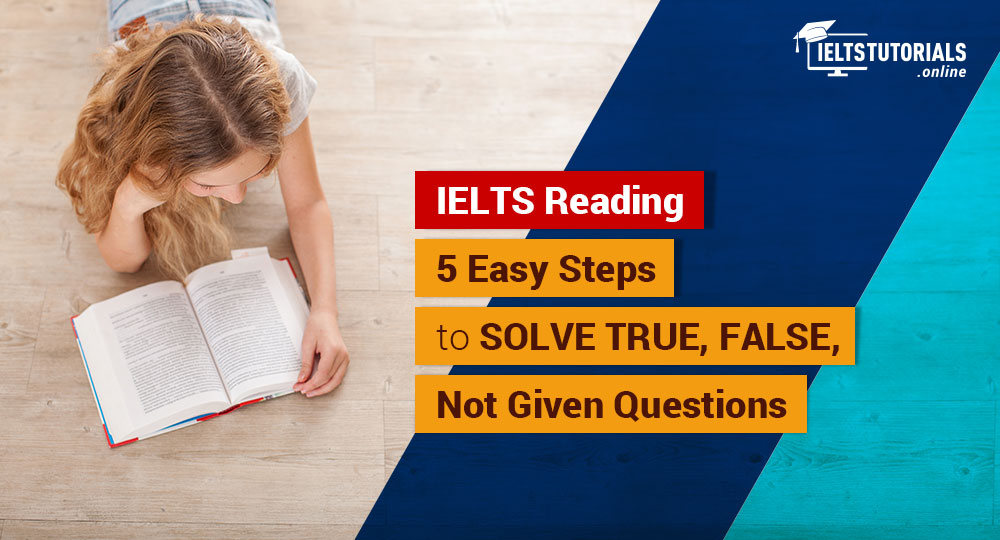
IELTS Reading: 5 Easy Steps to Solve True, False, Not Given Questions
You all must be aware of the True, False, Not Given question type of the IELTS Reading exam. In this, you will be given a passage, and 5-6 statements related to it. You will need to mark the given statements as True, False or Not Given.
The tricky part is that you might not get the sentences directly. Most of the time, there is a possibility of having rephrased sentences.
In this blog, following points are covered:
- How to approach the question?
- 5-step solving strategy
- Important patterns
- Common mistakes
- Quick tips
- How to solve (with sample question and explanation)
How to Approach True, False, Not Given Questions?
| True |
If the statement matches the information in the passage. |
| False |
If the statement contradicts the information in the passage. |
| Not Given |
If the information is not found in the passage. |
5-step solving strategy for IELTS Reading True, False, Not Given Questions
STEP I: Identify keywords in the statement
STEP II: Identify similar words in the passage
STEP III: Match the keywords and the similar words
STEP IV: Evaluate if they are same, synonyms, opposites or if there's no match
STEP V: Decide whether the statement is True, False or Not Given
Important Pattern to Notice in True, False, Not Given Questions
Consider the statements and the corresponding equivalent statements from the reading passage. Focus on:
- Paraphrasing: Sometimes, there are chances of getting rephrased sentences. It becomes easy to find whether the sentence is True, False or Not Given.
- Synonyms/Opposites: The best way to determine the sentences is just by looking at the keywords which can be either synonym or antonym.
Beware of Some Common Mistakes
- Don't get confused between False and Not Given.
This may sound obvious. But the statement does not necessarily have to be either True or False. At times the information may not be given in the passage.
- Never try to answer based on your prior knowledge of the topic.
The passage could be slightly different from your prior knowledge of the topic. Making assumptions can cost you a good IELTS score. Read the complete passage and then answer the questions based only on the given information.
Quick Tips for IELTS Reading True, False, Not Given
- The statements follow a chronological order. Once you find the first answer, proceed to the next sentence.
- Watch out for those words that can slightly change the meaning of the sentence. For example, many, some, never, few, all, always, etc.
- Don't waste too much time on one question. If you can't find one, mark it Not Given.
How to solve (with Sample Question and explanation)
Let's take a sample question:
|
Keywords in Statements |
Similar Words in Passage |
|
1. David Gura is trying to buy a book before it gets broken up. |
a single page from a medieval manuscript went up for sale. Among those who were trying to buy it was David Gura, |
|
2. David Gura works for the University of Notre Dame. |
David Gura, the Curator of Ancient and Medieval Manuscripts at the University of Notre Dame |
|
3. Only a small number of pages remain of The Book of Hours. |
He is now in a race to find the remaining pages of this manuscript before they disappear. |
Explanation
Statement 1: The statement mentions that David Gura is trying to buy a book before it gets broken up
On the contrary, you can find in the passage that only a single page from a medieval manuscript went up for sale. It can be seen that David Gura is one of the people trying to buy the page.
False.
Statement 2: It is a straightforward question and can be easily seen that David Gura works for the University of Notre Dame. Highlighted keywords also matched.
True.
Statement 3: It is stated that only a small number of pages remain of The Book of Hours
Yes, there are remaining pages, but it is difficult to conclude from the passage whether they are less or more.
NOT GIVEN.
Conclusion
Continue your IELTS Reading practice with the tips and techniques shared in this article.
It may take time in the beginning. Once you have practised and perfected the step-by-step strategy multiple times, it will get easier.
For more practice, visit IELTS Tutorials and sign up to get 20+ Free Practice Tests.
If you need the help of a tutor, but don't have the time for regular classes, you could also opt for IELTS Online Coaching.